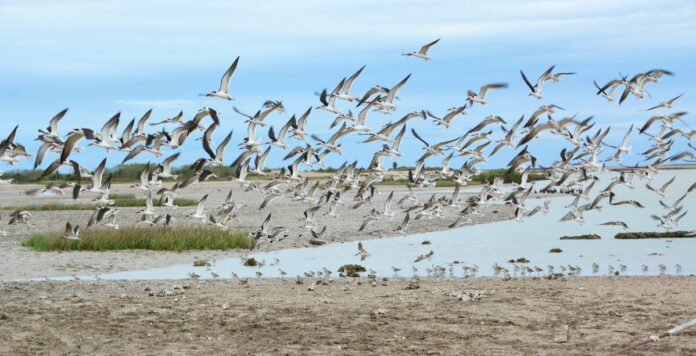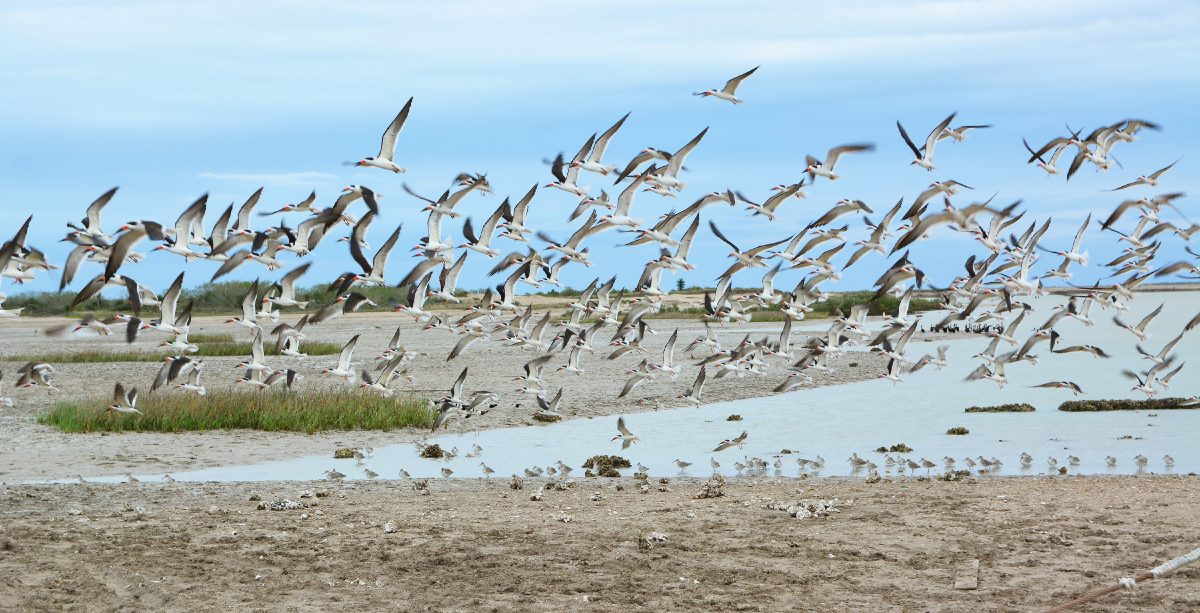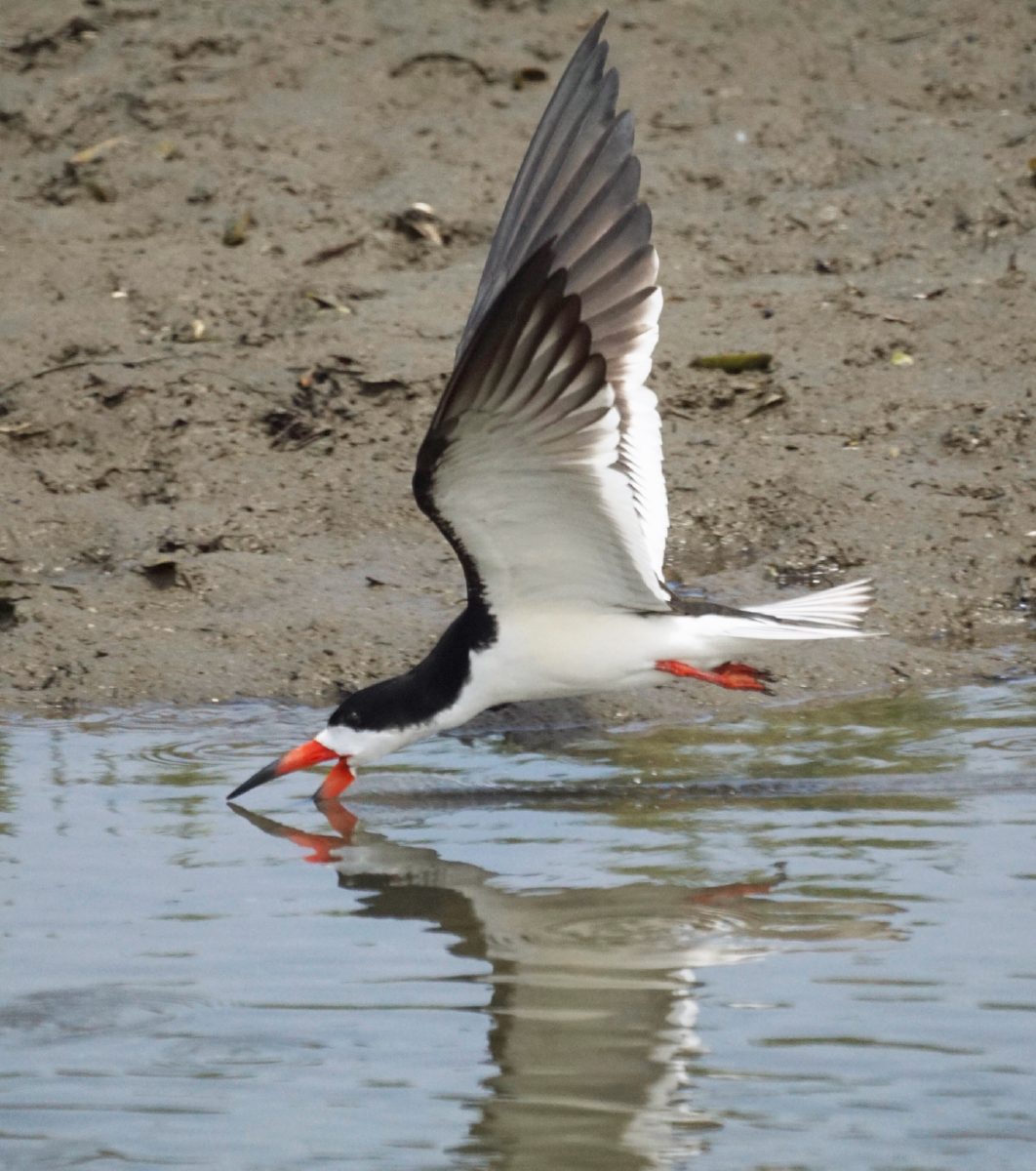HARLINGEN — The surf-side portrait is immediately recognizable.
Black above, white below, and if the bird is in the air, chances are its severely overshot lower jaw is ripping through the water as it buzzes low over the Laguna Madre, snapping up fish without breaking glide.
The black skimmer is one of three skimmer species worldwide but is the only one found in Texas and the United States.
Problem is these iconic shorebirds are in sharp decline in Texas, with estimates putting nesting pairs at 5,000 annually, half what it was 40 years ago.
“One of the things in order to find out why birds are declining, it could be a breeding problem, it could be other places they may be going, so we didn’t really know anything about where skimmers that breed in Texas were going in the winter,” said David Newstead, program director of the Coastal Bird Program which is part of the Coastal Bend Bays and Estuaries Program.
“So we used some satellite transmitters (attached to the birds) and found over half of the population in Texas spends the winter actually further south,” he added. “They cross Mexico at the Isthmus of Tehuantepec (137 miles of land, between the Gulf of Campeche and the Gulf of Tehuantepec on the Pacific Ocean), so they were wintering in southern Mexico and Costa Rica on the Pacific.”
Nesting spots
On the Texas gulf coast, black skimmers are particular about where they nest. The birds don’t make much of an effort, to be honest, just a hollow scraped out in the sand, maybe with a handful of twigs scattered around it.
Location to a skimmer, however, is everything. They don’t often nest on South Padre Island or on the mainland, preferring the isolated man-made spoil islands in the Laguna Madre, created years ago by dumping dredge tailings.
Newstead, who has been working with skimmers for about 15 years, says initial concerns began over why the birds were having difficulty with nesting success.
Each year for the past four decades, researchers and volunteers have cataloged numbers of bird species with the Texas Colonial Waterbird Survey, a census of sorts to estimate the numbers of all bird species which form colonies or rookeries along the gulf coast.
What they’ve found when it comes to black skimmers is fewer of them.
Slicing water
Black skimmers are easily recognizable even to birding novices. They’re big black and white birds with a wingspan of 42 to 50 inches, and a pronounced orangey-red and black beak.
That beak, though.
“They’re essentially like two knives coming together,” Newstead said. “They fly by dragging that lower mandible through water, shallow water, and when they encounter a fish, they snap shut and they swallow the fish. The lower mandible is very long so that’s about the depth of water they can fish in.
“They’ve got some other adaptations in their neck vertebrae, so if they encounter something that’s not a fish, like if they hit a stick or something like that, they’ll actually let go and their neck will like bend totally forward, more or less roll right over, so it won’t break their neck.”
Habitat loss
Like most species with numbers in decline, the black skimmer’s issue seems to be a lack of the right habitat.
“In Texas, they nest on these small islands that are between the barrier island and the mainland,” Newstead said. “The nearest colony down there to you would probably be the Laguna Vista spoils. Although there’s a Town of Laguna Vista, just offshore there are a couple of little islands and that’s the biggest local colony.
“Not only do these birds nest on bare ground like bare sand and shell hash substrate, but that’s been eroding away really badly everywhere,” he added. “These islands are losing in acreage every day, pretty much. It gets less and less every year.”
Newstead says some of the islands he saw with strong nesting populations 15 or 20 years ago are gone now, victims of the churning and unpredictable conditions found in the Laguna Madre. These small islands are losing their war with wind and tide.
While there have been projects to restore spoil islands, Newstead concedes it’s a difficult job, and one which he notes can get “very, very expensive.”
Even on the islands where black skimmers are still nesting, things are problematic.
“One of the biggest threats for the birds is that people are fishing too close to the islands and sometimes getting on the islands,” he said. “When they’re forced off their nest, their eggs and chicks are vulnerable to predators like gulls and other opportunists, like caracaras.
“Also in the heat of the summer, if they’re off for any extended period of time, the eggs, the chicks, will die just from the heat,” he added.
Citizen researchers
The Florida Shorebird Alliance has compiled a list of color-coded leg bands attached to eastern seaboard skimmers by researchers. They capture the birds using fine-meshed monofilament netting which snares the birds by the legs, after which they are measured, banded and quickly released.
The color-coded bands are orange for Massachusetts, yellow for New York, blue for New Jersey, white for Virginia, black for North Carolina, green for Florida and red for Texas.
“We tag all the birds that we catch and we put satellite transmitters on some of them,” Newstead said. “We put these engraved bands that you can read and report them. That’s really helpful. With a decent set of binoculars or scope, you can get close enough, or a photographer can get photos, and that would be extremely helpful.”
Newstead said banding skimmers in Texas is relatively new, and he worries people outdoors don’t yet know to be on the lookout.
Anybody fishing or beachcombing who sees one of these banded birds can play their part in black skimmer research. Any birds with identifiable bands can be reported at the website www.bandedbirds.org
“You’re more likely to see red tags here but you never know,” he said. “That’s telling us a lot that birds in Texas are not associating with birds in Florida or the birds in Virginia. Our birds are very definitely our issue, our problem. We can’t blame it on anybody else.”
Black skimmer facts
Scientific name: Rynchops niger
Common names: Stormgull, scissor-bill, shearwater, seadog, flood gull, razorbill and cutwater.
Identify: White underneath and black above. Wingspan between 42 and 50 inches. Forked tail. Half of bill is orange, outer half is black.
Bill development: After hatching, a black skimmer’s upper and lower mandibles are equal in length. By the time it’s ready to fly in about a month, the lower bill has grown a half-inch longer.
Enemies: Gulls, crows and raptors like crested caracaras are the primary natural predators. Others include dogs, cats and rats, all of which feed on eggs and chicks hatched and fledged in open nests near the beach.







